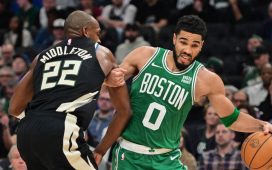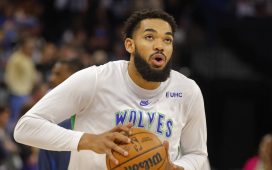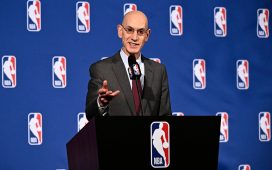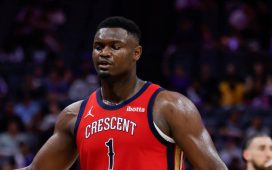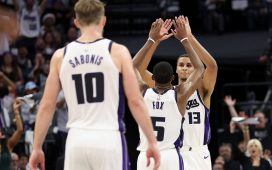In 27 games: 21-6.
That’s the Memphis Grizzlies’ record without Ja Morant this season, including the playoffs, and it’s not exactly in line with our expectations for how a team might play without a second-team All-NBA performer. Included in those wins are a 73-point beatdown of Oklahoma City and Wednesday night’s 134-95 disembowelment of Golden State in the Western Conference semifinals.
If anything, the record understates how well they’ve played without Morant. In addition to the two routs noted above, 14 of the other 19 wins without Morant were by double figures. Meanwhile, four of the six losses — including Game 4 against Golden State — were nail-biters. Overall, Memphis outscored opponents by a whopping 376 points in the 27 games without Morant (plus-13.9 per) and by just 133 points in the other 66 games (plus-1.7 per). And it’s not just that Oklahoma City game skewing the numbers either. Five of the Grizzlies’ seven wins this year by 30 or more points came without Morant.
“We deep,” was Taylor Jenkins’ short explanation of the phenomenon after Game 5, echoing an internal saying on the team and drawing bemused chuckles from Desmond Bane, Tyus Jones and Jaren Jackson Jr. when they were told of it.
That succinct summary does tell the story, to some extent. Memphis really is the league’s deepest team, with a Noah’s Ark roster that seemingly has two of everything amid 12 rotation-caliber players.
Yet while that tells a portion of the story, I’m not sure it tells the entire tale. The issue isn’t just that the Grizzlies have managed to avoid playing worse without Morant. It’s that they’ve actually played significantly better.
The Grizzlies outscored opponents by 4.1 points per 100 possessions with Morant on the floor this season and by 6.4 per 100 when he was off. In the postseason, it’s been the opposite — at plus-5.3 with Morant and plus-2.2 without — but that’s also a much smaller sample.
What changed about these games? What’s going on here? And perhaps most importantly, how does this inform what the Grizzlies do next?
At first, I wondered if Tyus Jones simply played better as a starter, but that doesn’t appear to be an impactful reason for the trend; his stats are almost exactly the same as a starter and a sub.
Instead, some other things stand out once you start wading deeper into the data. First, timing matters. Memphis’ first six weeks were radically different than the rest of its season; it’s easy to forget the Grizzlies limped out of the gate at 9-10 with a bottom-five defense before righting the ship. But even if you wipe out that stretch, the Grizzlies have hardly played better with Morant (plus-9.6) than without (plus-8.3) — and have been better with Jones (plus-11.7).
Alas, this is a pretty suspect line of inquiry in the first place. “We’re good if you just ignore all the times we weren’t” is generally poor data science. Let’s keep moving.
The other standout feature is how sharp the defensive splits are, regardless of which time block you choose. The Grizzlies give up more points per possession with Morant on the court than with any other rotation player, and that fact is immune to whatever arbitrary data endpoints you want to use. For the season, they give up 111.2 per 100 with Morant and just 105.3 without him. Similarly, the Grizzlies give up a team-best 105.5 per 100 with Jones on the court and a team-worst 109.3 without him.
Based on that, I can jump pretty quickly to a knee-jerk reaction that proclaims Morant a horrendous defensive player and declare that to be the entirety of the issue. Certainly he ain’t Jrue Holiday, but stay with me … there’s a lot more to unpack here.
For starters, there’s Lady Luck. Memphis opponents shot 34.4 percent from 3 and 79.4 percent from the line in Morant’s minutes and 32.4 percent from 3 and 77.3 percent from the line in Jones’. That’s about a three-points-per-100 difference between Morant and Jones that’s likely just random noise.
That said, Memphis also forced dramatically fewer turnovers in Morant’s minutes versus Jones’, which seems like a glaring red flag until you realize the Grizzlies also forced even fewer turnovers in Steven Adams’ minutes and massively more turnovers in those by Dillon Brooks, De’Anthony Melton and Kyle Anderson. Guess which players played more with Morant and which played more with Jones.
So who’s the chicken, and who’s the egg? That takes us directly to the biggest confounding issue: The other players on the court still matter, and there are some pretty big splits between which guard played with which teammates.
One player, in particular, impacts Memphis’ data a lot, and it’s not who you think.
Believe it or not, Memphis’ numbers this season — both in the regular season and, yes, in the playoffs — are markedly better with Brooks on the court. He only played 32 games this year, however, and only overlapped with Morant in 11 of them.
Memphis allowed just 105.9 points per 100 with Brooks on the floor and had a plus-11.0 net rating in his minutes; perhaps Jones is benefiting from having played significantly more minutes with the Grizzlies’ best wing defender (532, in which the Grizzlies were plus-8.3 per 100) than Morant did (215, in which the Grizzlies were an even better plus-12.2).
And that 21-6 record without Morant? That breaks down to 18-4 when Brooks plays and 3-2 when he doesn’t. Meanwhile, the Grizzlies’ “Core 4” unit of Morant, Bane, Brooks and Jackson played only 125 minutes together this year but smoked opponents by 20.2 points per 100, including a 97.0 defensive rating. In the playoffs, it’s been more of the same, with a plus-9.4 net rating in 109 minutes.
That same core — but with Jones at the point instead of Morant — was just plus-2.3 in 226 minutes. Oh … now the data looks a little messier, huh?
To really inform this debate, however, we can zoom the camera back out and focus deeper than just Brooks. Let’s look more generally at how each rotation player does with Jones versus Morant:
Grizzlies plus-minus per 100 by PG
| Jones min | Jones +/- | Morant min | Morant +/- | |
|---|---|---|---|---|
|
Bane |
791 |
8.1 |
1201 |
2.8 |
|
Jackson |
928 |
9.8 |
1055 |
5.9 |
|
Brooks |
532 |
8.3 |
215 |
12.2 |
|
Adams |
712 |
9.7 |
1291 |
5.8 |
|
Anderson |
537 |
11.1 |
807 |
-2.4 |
|
Clarke |
625 |
8.9 |
467 |
7.9 |
|
Melton |
590 |
5.8 |
783 |
4.2 |
|
Williams |
368 |
13.4 |
780 |
0.4 |
|
Konchar |
435 |
0.4 |
351 |
5.2 |
What stands out is that Jones is less dependent on needing shooting around him and more able to play off the ball. The numbers for Anderson jump off the page in that respect; with Morant a shaky shooter, a non-shooter at center nearly full-time (Memphis only occasionally plays Jackson in the middle because of his prodigious accumulations of fouls in that role) and Morant nearly always on the ball, there is no breathing room for Slo-Mo to do his thing.
But wait … there’s more!
What about how the team plays when neither Jones nor Morant is on the court. Remember, in the non-Morant games, the Grizzlies didn’t have another traditional backup point guard on the roster, instead relying on Bane, Melton or Anderson to initiate offense.
And yet, it didn’t seem to hurt them. Lineups without either of the two point guards still outscored the opposition comfortably, by nearly 10 points per 100 possessions overall. With Bane at the point, the Grizzlies punched above their weight offensively; when Melton was the nominal point guard, the Grizzlies struggled on offense but were so awesome on defense (99.0 points per 100!) it didn’t matter.
(Note: Anderson often ran the offense in these lineups, but there were no instances of him playing without one of Bane, Melton, Morant or Jones on the court. At least, until Wednesday’s garbage time, that is.)
As I said, there’s a lot to unpack, and this is what teams are dealing with all the time during the course of a season: Trying to figure out, in the middle of the fog of war, whether data like the team’s record without Morant corresponds to something deeper than statistical noise and shooting variance.
The next step is even more complicated: Using it to answer questions that can guide the team’s strategy going forward. Is Memphis really better without Morant? Is Jones worth paying a princely sum in free agency? Is Anderson? What kind of players can work best next to both Morant and Jones? Will this article ever end?
In the Grizzlies’ case, it appears much of the disparity corresponds to the availability of other players to play when Morant was healthy, and to shooting variance as well. I kept it simple with the on-off data, but this conclusion also is supported by more advanced lineup data that accounts for shooting luck. Those metrics see Morant as a lights-out superstar and Jones (not to mention Anderson and Brooks) as more complementary pieces.
There is still information here, though, especially as Memphis plans for what could be a very interesting offseason. Even allowing for the shooting splits, Morant’s defense is negative enough that his overall presence on the court is perhaps less impactful than you’d otherwise expect. That, in turn, suggests the Grizzlies might be better off if he tilted more energy that way, even if it came with an offensive cost.
More importantly, there is some interesting information regarding both Jones and Anderson, each of whom happens to be an unrestricted free agent this summer. Jones has received the lion’s share of the attention given how well the team has played when he starts, and the numbers (and eye test) indicate he allows funky non-shooters like Anderson to thrive.
But the data also shows that Memphis has been able to succeed at roughly the same level in “no point guard” lineups with multiple secondary ballhandlers like Bane, Melton and Anderson. If that’s the case, would Memphis rather bring back Anderson if it can only choose one?
In the immediate future, meanwhile, the data points us back to a couple of more glaring realities. First, even with some of the defense and Anderson-enabling benefits that Jones brings, the Grizzlies are clearly worse off without Morant (I know, I know: Thanks for the extensive rocket science that gave us that landmark conclusion, Einstein.) As awesome as they were in Game 5, they’re underdogs in Game 6.
At the margins, however, the Grizzlies might be in better shape than they think. Memphis has Brooks back, and despite his shooting slump, his presence with Jackson and Bane has been monstrous — plus-10.2 per 100 in the regular season and plus-17.5 in the playoffs. Meanwhile, the Grizzlies played Jones 41 minutes in Game 3, and he seemed to fatigue at the end. But the data shows the Grizzlies have survived incredibly well in “no point guard” alignments. They might be able to sustain longer stretches of Melton/Anderson-type groupings in a must-win Game 6, and that might also point the way to an alternate version of their future.
Related reading
Katz: Grizzlies’ possession production serves up a rout
(Photo of Tyus Jones and Taylor Jenkins: Joe Rondone / USA Today)

